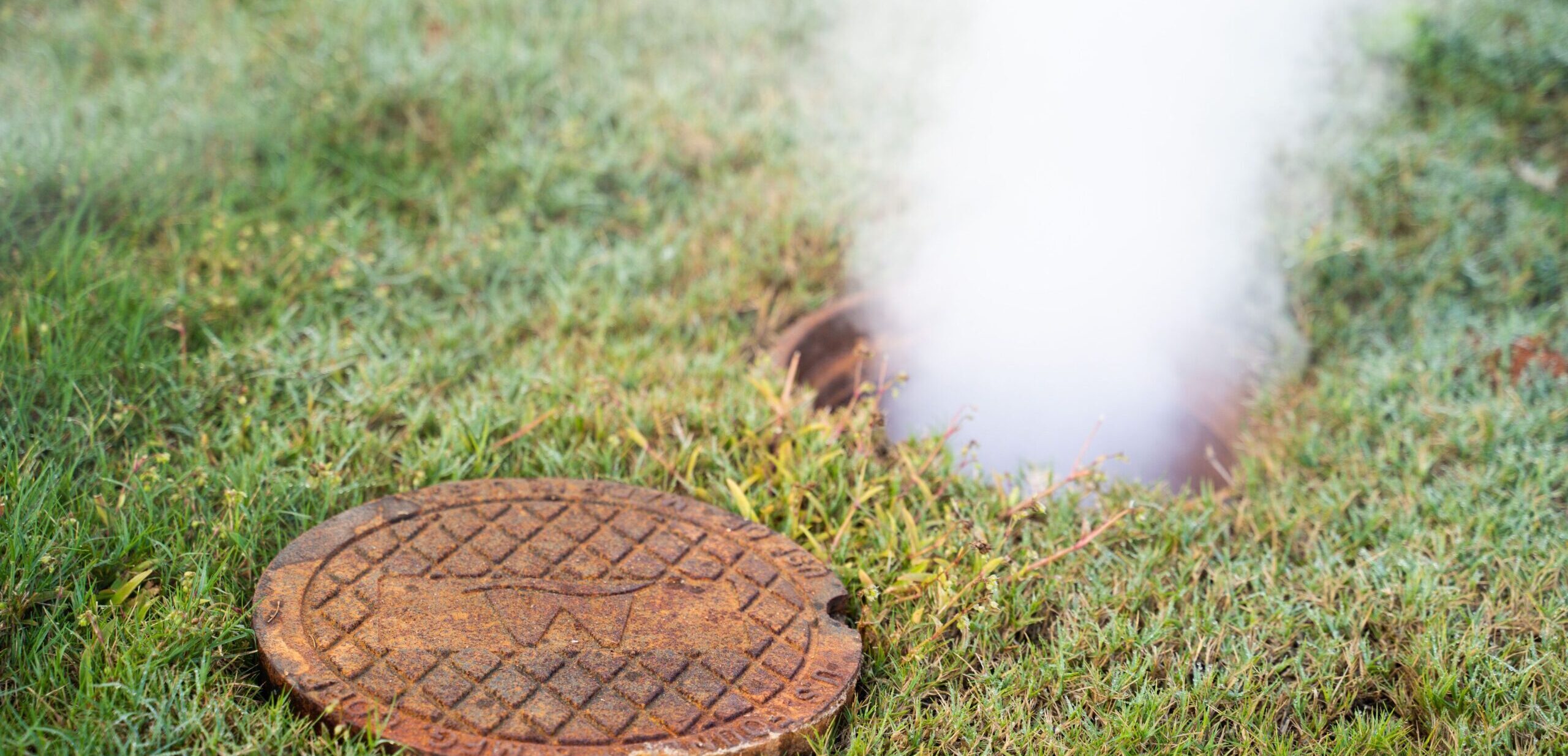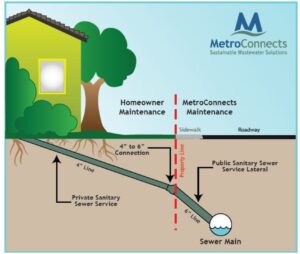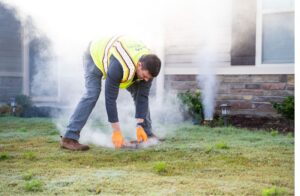- Smoke and dye testing are quick, easy ways for MetroConnects to detect leaks in sewer lines.
- Preventing and repairing leaks helps to protect the environment and public health.
- If you suspect you have a leak, call MetroConnects at (864) 277-4442.

Sanitary Sewer Systems: A Crucial Job
Our sanitary sewer systems have one crucial job: Move wastewater from your home or business to a wastewater treatment plant. When this job gets disrupted, we all have a big mess on our hands! It might be obvious when a plumbing disruption occurs inside our homes — toilet and sink backups, for example. However, we might be less aware when a disruption occurs outside and underground. A stealthy leak in a lateral sewer line might go unnoticed for some time, but a major backup or sewer overflow may not be too far behind. That is where MetroConnects can help. Smoke and dye testing are quick, easy ways to detect leaks in sewer lines so that we can protect the environment and protect you.
What Happens When a Lateral Has Leaks?

“Sanitary sewer laterals” are the pipes that run from your home or business out to the street and into the main sewer line (see Fig. 1). While these pipes often do their jobs with no problems for decades on end, issues sometimes occur. Roots from nearby trees can invade the pipes, soil can shift causing compression and cracks, and older pipes and manhole covers can deteriorate with age. Wastewater, or “gray” and “black” water, can leak from these cracks into the ground, possibly contaminating groundwater and soil, or even causing toxic sewer gas to be released inside your home.
Problems with I&I
“Inflow and Infiltration” (“I&I”) is another problem that can occur when there are leaks or cracks in sewer pipes. I&I refers to any water other than grey or black water that enters into sanitary sewer systems. Stormwater, for example, normally flows to storm drains and is released into the nearest water source, be it a lake, river, stream or ocean. However, it can enter into the sanitary sewer system through leaky pipes or manhole covers. Excess I&I can overwhelm a sewer system, causing sewage to overflow and spill out of manholes, or even to back up into homes. I&I can also make its way to wastewater treatment facilities, creating extra treatment expenses and potentially catastrophic slowdowns to water treatment and distribution, like what occurred last August in Jackson, Mississippi.
Prevention Through Detection
To prevent leaks from becoming a problem, we have to know when and where they are occurring. Once a leak is detected, MetroConnects and property owners can work together to create a plan to perform necessary maintenance and repairs. A bonus of being a MetroConnects customer is that we will perform necessary repairs and maintenance on the portion of your lateral that runs at or near the property line in the public right-of-way to the street. Some signs that you have a lateral pipe leak might include:
- Odors coming from your drains. This can mean a leak is occurring somewhere outside your home and causing toxic sewer gas to make its way into your home. Call MetroConnects at (864) 277-4442 right away if you notice unexplainable odors coming from your drains — chronic exposure to low levels of sewer gas, or short exposures to higher levels, can cause sewer gas poisoning.
- Slow drains. While a toilet backup or sink that is slow to drain could mean a small clog at the source, if more than one appliance in your household is struggling to drain, this might be a sign of a larger issue in your pipes outside. Cracks or root infiltration could be the culprit.
- Soggy and/or lush lawns. Leaky pipes not only allow water to seep into your yard but nutrient-rich human fecal matter as well. Your lawn might appreciate the nutrients, but it is not a good landscaping practice for your health! Yuck!
- Wet spots, mold or mildew. These can all be signs of cracks in a sewer line or a broken water pipe. The spores from mold can cause allergic reactions and permanent damage to your home.
- Cracks in slabs or walls. This could be a sign of soil settling beneath a foundation, but it could also be a sign of leaky pipes washing soil away.
Pinpoint the Problem: Smoke and Dye Testing

Smoke and dye testing are two of the most common ways to determine if and where a leak is happening. Both are non-toxic, non-invasive forms of detection. “Smoke Testing” is one of the quickest and most cost-efficient modes of testing for leaks. To perform a smoke test, MetroConnects crews will set up a blower to pump non-toxic, simulated “smoke” through a sanitary sewer line. If there are leaks in the pipes, smoke will begin to escape and rise out of the ground where there is a problem.

To prepare for a smoke test, residents should pour a gallon of water into any open drain traps, basement sinks and floor drains to prevent smoke from coming in through these openings into the home. If smoke does enter the home, that is a good indicator that there is a sewer leak somewhere inside, and should be repaired. Remember, the smoke is not harmful — it is actually just a mist containing a large percentage of atmospheric moisture that is highly visible at low concentrations. That being said, people with respiratory problems should let MetroConnects know prior to the test so that proper precautions can be taken. You will be notified by MetroConnects if smoke testing is planned in your area.
“Dye Testing” is also quick and efficient. For this process, non-staining, non-toxic dye is pumped through drains or downspouts. Crews then monitor the area to see if any dyed water appears, indicating cracks or other problems.
If a problem is detected through the smoke or dye test, MetroConnects can further analyze the system using CCTV technology and other techniques to determine what steps need to be taken to clean or repair the pipes.
Contact Us
If you suspect you have a leaky lateral, call MetroConnects at (864) 277-4442. Together, we can pinpoint the problem in order to protect the environment and protect you.
Sign up for our newsletter for more tips and to keep up on MetroConnects news.
Sanitary Sewer Terms
Sanitary sewer laterals: The pipe that carries wastewater from your home to public sanitary sewer mains, which are typically located in the street. The private portion of the lateral runs from your property’s right-of-way to your home. MetroConnects takes care of the public portion, which runs from your property line or right-of-way to the sewer mains owned by Metro or ReWa.
Gray and black water: Grey water is all used water that comes from your drains. This can include sink, shower, and laundry water. Black water is water contaminated with human waste and comes from toilets.
Inflow and Infiltration (I&I): Infiltration is groundwater that enters sewer pipes through cracks, leaky pipe joints, connection failures, and deteriorated manhole covers. Inflow is when stormwater enters sanitary sewer collection systems through direct connections such as yard drains or defective manhole covers, or through indirect connections with storm sewers.
Smoke and Dye Testing: Quick, clean processes that can be used to identify when and where leaks in sewer systems are occurring.